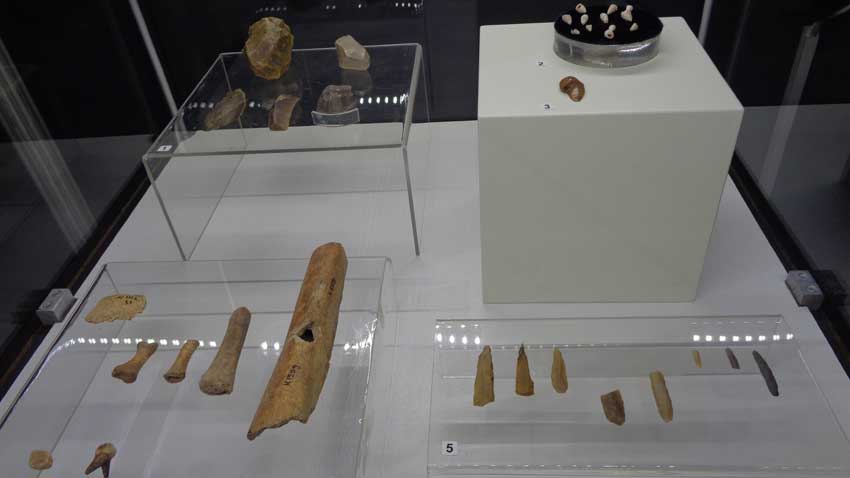The Eight National Archeological Exhibition Bulgarian Archaeology 2014 was launched in Sofia. All citizens and guests of the Bulgarian capital have the opportunity to see the most interesting finds from the last archaeological season until March 29. The National Archaeological Institute with Museum with the Bulgarian Academy of Science and sixteen other Bulgarian museums take part at this year’s edition. “2014 was a very successful year for us. We made a number of interesting finds”, Keeper of the National Archaeological Museum Associate Professor Ludmil Vagalinsky told Radio Bulgaria and added:
“In 2014 the number of our archaeological fieldworks was at a record high”, says Ludmil Vagalinsky, “We carried out over 400 surveys, including observations and explorations. I doubt that we would be able to repeat this any time soon.”
The intensive archaeological season was due to the engagement of Bulgaria’s archaeologists to explore sites close to the future routes of Struma and Maritsa motorways, gas pipelines and railway lines.
“Along with the development of the infrastructure projects, Bulgaria’s cabinet allotted in 2014 three times more money for archaeological research, as compared to the state finance granted in the previous 5 years. I do not know whether we would receive similar financing in 2015”, Associate Professor Vagalinsky pointed out. “Speaking of money quantity I can say that the money granted last year was at a record high level. However, I would dare saying that the Bulgarian archaeologists did a brilliant job again. Now we would like to show the society why and how the money of the regular taxpayer is spent. That is why we launched this exhibition.”
A total of 23 archaeological sites with over 280 finds are on display at the exhibition. Nearly 30 other locations are presented with posters only. The framework of the researches made in 2014 cover the time from the Paleolithic period until the Late Middle Ages. Some traditional researches of Bulgarian capitals, the Necropolis of the ancient coastal town of Apollonia (Present-day Sozopol) and other significant sites have been going on for decades now. A Bulgarian-French team headed by renowned archeologists Nikolay Sirakov and Jean-Luc Guadelli is now studying the secrets of Kozarnika Cave in Northeastern Bulgaria, where traces of the first human presence in Europe were found. Last year an ancient jewelry factory used by the people from the Paleolithic Era was discovered.

“We found single pieces of jewelry in past seasons, but we did not pay special attention to them. However, we found out later that we are talking about an organized manufacture, a workshop for personal jewelry back in that remote period”, Associate Professor Nikolay Sirakov said. “The ancient people used mainly fossils of snail shells and sometimes fossils of mussels. The Paleolithic people discovered these fossils near the Danube in several erosion cracks. Some of them were processed, i.e. these people used to pierce the fossils and use them as personal jewelry such as earrings, necklaces, brooches, etc. When we say personal jewelry we mean a very significant fact. We are talking about the beginning of the personal and the group self-identification. In other words, we see rudiments of ethno-linguistic communities.”
In the course of the researches the archaeologists found a statuette of a gorgeous female figure shaped in accordance with the taste of the ancient Paleolithic people. This is the first statuette of this kind found in the Balkans, archeologist Aleta Guadelli noted. “We presume that it was made of bone, yet we do not know the exact type of the animal these bones belonged to. It could be either a bison, or an elk.” Aleta is extremely satisfied with the discovery of an arm fragment which belonged to a Neanderthal baby which was born 130,000 years BC. Archeological finds of such type are extremely rare worldwide.
English version: Kostadin Atanasov
Archaeologists from the Historical Museum in the town of Gorna Oryahovitsa have discovered a settlement of the Cumans this summer during the excavations of a medieval necropolis east of the Thracian fortress of Rykhovets near the town of Gorna..
Not far from the town of Lovech, between the villages of Doirentsi and Drenov, during the construction of the future route of the Hemus motorway, a seven-thousand-year-old pit sanctuary surrounded by a ritual ditch was discovered . Its exploration began..
On one of the hottest days of summer, 20 July, the Christian Orthodox church honours the prophet Elijah. Many churches around the country have been named after the Old Testament prophet. According to the bible, Elijah lived in the 9 th century BC...

+359 2 9336 661
